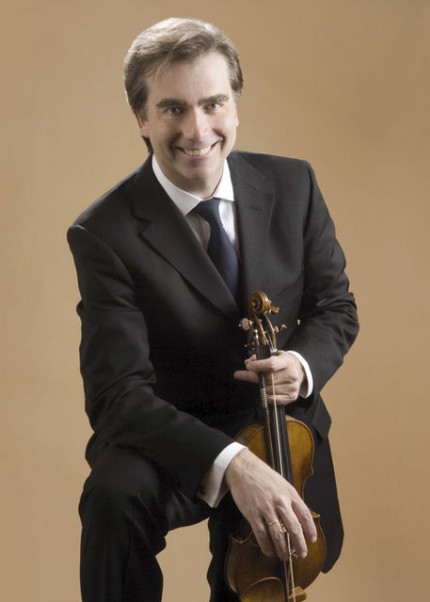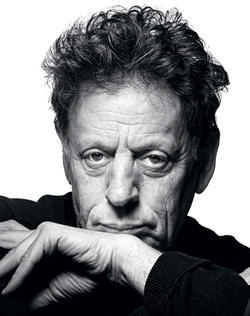New Glass violin concerto a work for all seasons

Robert McDuffie gave the Chicago premiere of Philip Glass's Violin Concerto No. 2 Sunday at the Harris Theater. Photo: Christian Steiner
Few premieres receive the kind of instantaneous standing ovation, cheers and prolonged applause that greeted soloist Robert McDuffie following the whirlwind final bars of Philip Glass’s Violin Concerto No. 2
The Chicago debut of Glass’s new concerto took place Sunday at the Harris Theater, performed by the American violinist and the Venice Baroque Orchestra to a packed house as part of their 30-city tour giving a royal sendoff to this work.
McDuffie, who commissioned the concerto, wanted a companion piece to Vivaldi’s omnipresent Four Seasons, hence the cumbersome subtitle, The American Four Seasons. Glass’s concerto is thus cast in four movements, each preceded by a solo violin introduction, and scored for small string ensemble like the Vivaldi, with the modern addition of a keyboard synthesizer.

Philip Glass
The composer has stated that any seasonal inspiration was largely an afterthought. Since Glass and McDuffie couldn’t agree on which movement corresponded to which season, they are left unidentified, so each listener can find their own sequence of seasons while hearing the piece.
At 40 minutes, The American Four Seasons is a more expansive work than its predecessor, Glass’s 1987 Violin Concerto, which remains one of his most popular concert works. As with many recent Glass compositions, there is a darker expressive profile to the music, though Glass’s characteristic handprints are here in the pulsing rhythmic impetus, idiomatic writing for violin and bravura opportunities for the soloist.
The solo sections that introduce the four movements (a Prologue and three “Songs”) inhabit a similar inward-looking expression, ranging from meditative to sweetly lyrical, albeit more angular with Song No. 2, though a searching quality predominates.
As he demonstrated with his recording of the earlier Glass concerto, McDuffie has a clear feel for the composer’s idiom, the subtle rhythmic shifts, tender lyricism and rock-like drive.
As far as the mystery sequence of the seasons, my guess is autumn, winter, spring, summer (though the final sections could also suggest dramatic winter winds). There was a feeling of a harvest dance and horse canter in the opening movement and a fleeting echo of Vivaldi’s Winter violin solo in the second.
Regardless of the marketing-friendly do-it-yourself climatology, Glass’s Violin Concerto No. 2 was given a sensational performance by McDuffie and his Italian colleagues Sunday afternoon, and this is a terrific new addition to the composer’s prodigious oeuvre.
Glass said that thoughts of Vivaldi had minimal impact on his music, but the first movement indicates otherwise. There is a jaunty neo-Baroque feel spiced by the synthesizer in jangly harpsichord-like mode with a strong suggestion of the Italian composer in the furioso tuttis.
The second movement has an air of subdued sorrow and the melancholy main theme is one of Glass’s most indelible inspirations. In the third, the music turns more driving and insistent with sudden dynamic crescendoes, the virtuosic violin writing echoed by some equally showy solos for the synthesizer.
The exhilarating final section offers some of the most unapologetically brilliant fireworks in Glass’s entire canon, with the speed and violinist’s technical difficulties ratcheted up higher and higher until the thrilling, blistering coda. With the work’s economical scoring, Glass’s Second Violin Concerto should quickly overtake his First in popularity and number of performances.
The first half was hardly less involving with the Vivaldi music that sort-of inspired the Glass concerto.
McDuffie and the Italian musicians—here reverting to their usual period instruments—banished any hint of routine in this familiar music. The outer moments had tremendous verve, from McDuffie and the ensemble alike, the Venice players producing a rich sonority for just 18 players.
Slow movements were especially enjoyable with McDuffie sitting cross-legged next to the orchestra’s lutenist, Ivano Zanenghi. Zanenghi’s imaginative continuo contributions and clear enjoyment in the music-making were delightful, his exchanges with McDuffie—musical and verbal—offering the relaxed give-and-take of a Baroque jam session.
Posted Oct 25, 2010 at 2:51 pm by Jeff
Amazing performance. Part of the piece is online, letting you guess which movement is which season at americanfourseasons.com. Very cool…